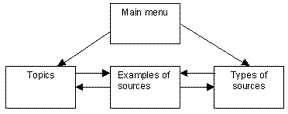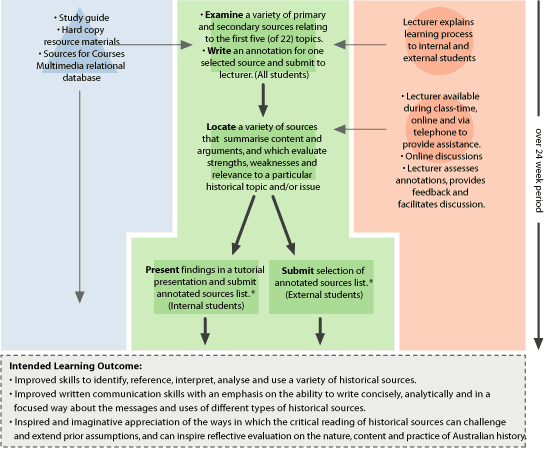|
ACCESSIBLE RESOURCES
Study Guide:
All students receive a printed copy of the Study Guide which
provides an introduction to the various topics in the unit,
the organisation of the unit, and the learning tasks involved.
It includes guidelines about referencing and about the purpose
and nature of different types of historical sources. It also
includes examples of annotations of different types of sources,
and guidelines and criteria to assist students to research
and write their own annotations.
Resource Materials:
Printed Resource Material booklets are available which provide
one or two examples of sources for each of the topics studied
during the course. A directed reading guide which consists
of key questions which students should seek to answer through
their reading of the source accompanies each source.
Sources for Courses Multimedia Database:
The Sources for Courses database builds on and extends the
approach adopted in the printed Study Guide and Resource Materials.
It consists of a database created in Filemaker Pro which takes
advantage of Filemaker's multimedia and relational database
features to create examples and exercises about historical
sources which can be linked both to specific topics and to
a discussion of some of the different types of sources available
to the historian. The aim is not to provide students with
static information. Rather, it is to assist and stimulate
them to seek, read, question and analyse a variety of sources.
It is intended that the database will be made available
on CD-ROM as part of the teaching package supplied to students.

Figure 1: Main menu for Sources for Courses
database.

Figure 2: There are three related databases.
Examples of Sources:
This database provides a selection of specific sources. Each
source is given its full reference details, is illustrated
and is accompanied by a reading guide which requires students
to be able to answer certain questions based on their reading
of the source.
Topics:
This database provides introductory overviews for a number
of Australian history topics. These are presented as slide
shows which provide basic headings, questions and illustrations
about the topic. Students can print out the text of the slide
show. By clicking on the 'Examples of sources' button they
can then pull up a selection of sources relevant to that topic
from the 'Examples of Sources' database. The intention is
that they select from these sources as a starting point for
their study of the particular topic. Their ''reading' is guided
both by the directed reading questions in the 'Examples of
Sources' database and the questions and activities built into
the slide show and the 'Topics' database.
Types of Sources;
This database provides an introduction to ways of 'reading'
and analysing different types of sources (e.g. government legislation,
films, oral histories, letters ) used by historians . As in
other sections of the database, the emphasis is on encouraging
students to think and question, not just absorb information.
There are review questions and exercises to assist in the
process. By clicking on the 'Examples of sources' button students
can pull up a selection of examples of this type of source
as well as references to analytical texts about the particular
type of source.
Help
There is a help page which can be accessed from any page in
Sources for Courses.
RESOURCES IN CONTEXT
The mixture of printed and multimedia material in the resource
set addresses a number of important issues. It recognises
that, for many students, study guides, assessment tasks, and
reading lists are useful in a printed form which is portable,
can be kept available for constant reference and can be annotated.
Printed resource materials similarly address the issue of
familiarity and, importantly, are a reminder that a substantial
amount of the sources available to historians are in the printed
form. The multimedia database complements these more traditional
forms and is important in its ability to introduce students
to a wider range and variety of historical sources, ideas,
information, exercises and guides than can be presented in
printed form. The multimedia database is also significant
in its ability to provide examples of a variety of media (e.g. photographs, films, sound recordings, printed documents) which
can be accessed and 'read' in relation to a variety of different
historical issues and topics.
VARYING THE RESOURCE SET
The variety of resources cater for the different learning
styles of students, and address slightly different needs.
The printed Study Guide provides a portable, available resource
for constant reference. The printed Resource Materials are
familiar for those students (especially among mature-age external
students) who still feel uncomfortable with electronic-only
material. The printed Resource Materials are also a reminder
that this is the form in which many historical sources are
encountered and 'read'. The multimedia database enables a
wider selection and quantity of sources, invites non-linear
exploration of the material, and takes advantage of the capabilities
of the new technologies.
|


